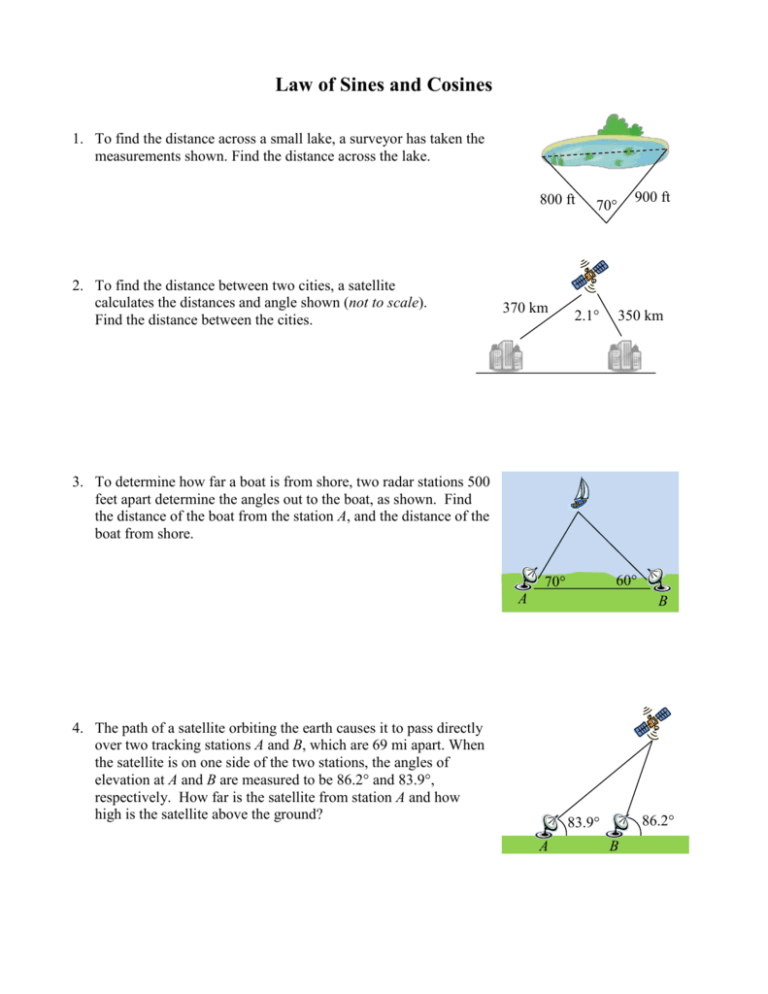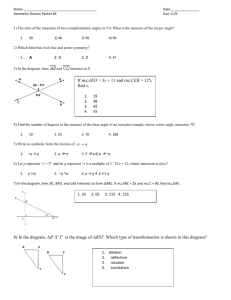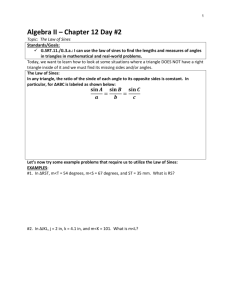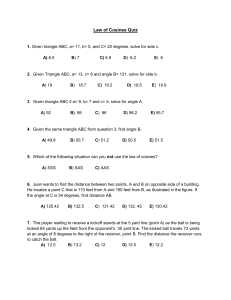4.5.2 Law of Sines and Cosines
advertisement

Law of Sines and Cosines 1. To find the distance across a small lake, a surveyor has taken the measurements shown. Find the distance across the lake. 800 ft 2. To find the distance between two cities, a satellite calculates the distances and angle shown (not to scale). Find the distance between the cities. 370 km 900 ft 70° 2.1° 350 km 3. To determine how far a boat is from shore, two radar stations 500 feet apart determine the angles out to the boat, as shown. Find the distance of the boat from the station A, and the distance of the boat from shore. 60° 70° A B 4. The path of a satellite orbiting the earth causes it to pass directly over two tracking stations A and B, which are 69 mi apart. When the satellite is on one side of the two stations, the angles of elevation at A and B are measured to be 86.2° and 83.9°, respectively. How far is the satellite from station A and how high is the satellite above the ground? 86.2° 83.9° A B 5. A communications tower is located at the top of a steep hill, as shown. The angle of inclination of the hill is 67°. A guy-wire is to be attached to the top of the tower and to the ground, 165 m downhill from the base of the tower. The angle formed by the guy-wire and the hill is 16°. Find the length of the cable required for the guy wire. 16° 165m 67° 6. The roof of a house is at a 20° angle. An 8 foot solar panel is to be mounted on the roof, and should be angled 38° relative to the horizontal for optimal results. How long does the vertical support holding up the back of the panel need to be? 8 ft 38° 20° 7. A 127 foot tower is located on a hill that is inclined 38° to the horizontal. A guy-wire is to be attached to the top of the tower and anchored at a point 64 feet downhill from the base of the tower. Find the length of wire needed. 127 ft 64 ft 38° 8. A 113 foot tower is located on a hill that is inclined 34° to the horizontal. A guy-wire is to be attached to the top of the tower and anchored at a point 98 feet uphill from the base of the tower. Find the length of wire needed. 113 ft 98 ft 34° 9. A pilot is flying over a straight highway. He determines the angles of depression to two mileposts, 6.6 km apart, to be 37° and 44°, as shown in the figure. Find the distance of the plane from point A, and the elevation of the plane. 37° A 10. A pilot is flying over a straight highway. He determines the angles of depression to two mileposts, 4.3 km apart, to be 32° and 56°, as shown in the figure. Find the distance of the plane from point A, and the elevation of the plane. 44° B 32° 56° A B 11. To estimate the height of a building, two students find the angle of elevation from a point (at ground level) down the street from the building to the top of the building is 39°. From a point that is 300 feet closer to the building, the angle of elevation (at ground level) to the top of the building is 50°. If we assume that the street is level, use this information to estimate the height of the building. 12. To estimate the height of a building, two students find the angle of elevation from a point (at ground level) down the street from the building to the top of the building is 35°. From a point that is 300 feet closer to the building, the angle of elevation (at ground level) to the top of the building is 53°. If we assume that the street is level, use this information to estimate the height of the building. 13. A pilot flies in a straight path for 1 hour 30 min. She then makes a course correction, heading 10 degrees to the right of her original course, and flies 2 hours in the new direction. If she maintains a constant speed of 680 miles per hour, how far is she from her starting position? 14. Two planes leave the same airport at the same time. One flies at 20 degrees east of north at 500 miles per hour. The second flies at 30 east of south at 600 miles per hour. How far apart are the planes after 2 hours? Selected Answers: 1. Because the angle corresponds to neither of the given sides it is easiest to first use Law of Cosines, to find the third side. According to Law of Cosines 𝑑2 = 8002 + 9002 − 2(800)(900)cos(70) where d is the distance across the lake. d = 978.51ft 800 ft 70° 900 ft 3. To completely understand the situation it is important to first draw a new triangle, where ds is the distance from the boat to the shore and dA is the distance from station A to the boat. 60° 70° A B 𝑑𝐴 𝑑𝑠 70° 60° Since the only side length given does not have a corresponding angle given, the corresponding angle 500ft (θ) must first be found. The sum of all angles in a triangle must be 180°, so 180° = 70° + 60° + 𝜃, 𝑎𝑛𝑑 𝜃 = 50°. Knowing this angle allows us to use Law of Sines to find dA. According to Law of Sines sin(60) 𝑑𝐴 ⇒ 𝑑𝐴 = 500sin(60) sin(50) sin(50) 500 = ≈ 565.26𝑓𝑡. To find ds, trigonometry of the left hand right triangle can be used. 𝑑𝐴 = sin(70)565.26𝑓𝑡 ≈ 531.17𝑓𝑡. 5. The hill can be visualized as a right triangle below the triangle that the wire makes, assuming that, a line perpendicular to the base of 67° angle is dropped from the top of the tower. Let L be the length of the guy wire. 16° 165m 67° λ φ L In order to find L using Law of Cosines, the height of the θ tower, and the angle between the tower and the hill need to 16° be found. 165m To solve using Law of Sines only the angle between the guy wire and the tower, and the angle corresponding with L need 67° to be found. Since finding the angles requires only basic triangle relationships, solving with Law of Sines will be the simpler solution. The sum of all angles in a triangle is 180°, this rule can be used to find the angle of the hill at the tower location (θ). 180° = 90° + 67° + 𝜃, 𝑠𝑜 𝜃 = 23°. θ and the angle between the tower and the hill (φ) are supplementary angles, so 𝜃 + 𝜑 = 180°, thus 𝜑 = 157°. Using once again the sum of all angles in a triangle, 𝜑 + 16 + 𝜆 = 180, 𝑠𝑜 𝜆 = 7°. According to Law of Sines, sin(7) 165 = sin(157) 𝐿 , so 𝐿 = 165sin(157) sin(7) ≈ 529.01 𝑚. 7. Let L be the length of the wire. 127 ft The hill can be visualized as a right triangle, assuming that a line perpendicular to the base of the 38° angle is dropped from the top 38° of the tower. 127 ft L 64 ft 38° 64 ft θ λ Because two sides of the triangle are given, and the last side is what is asked for, it is best to use Law of Cosines. In order to use Law of Cosines, the angle θ corresponding to L needs to be found. In order to find θ the last angle in the right triangle (λ) needs to be found. The sum of all angles in a triangle is 180°, so 180° = 38° + 90° + λ, and λ = 52°. λ and θ are suplimentary angles so 𝜆 + 𝜃 = 180° , and θ = 128°. According to Law of Cosines, 𝐿2 = 1272 + 642 − 2(127)(64) cos(128) , so 𝐿 = 173.88𝑓𝑡. 9. Using the relationship between alternate interior angles, the angle at A inside the triangle is 37°, and the angle at B inside the triangle is 37° 44°. d A e 37° 6.6km 44° B 44° Let e be the elevation of the plane, and let d be the distance from the plane to point A. To find the last angle (θ), use the sum of angles. 180° = 37° + 44° + θ, so θ = 99°. Because there is only one side given, it is best to use Law of Sines to solve for d. According to Law of Sines, sin(44) 𝑑 = sin(99) 6.6sin(44) 6.6 sin(99) , so 𝑑 = ≈ 4.64 km. Using the right triangle created by drawing e and trigonometry of that triangle, e can be found. 𝑒 = 4.64 sin(37) ≈ 2.79 km. 11. Assuming the building is perpendicular with the ground, this situation can be drawn as two triangles. Let h = the height of the building. Let x = the distance from the first measurement to the top of the building. h 39° 50° 300ft In order to find h, we need to first know the length of one of the other sides of the triangle. x can be found using Law of Sines and the triangle on the right. The angle that is adjacent to the angle measuring 50° has a measure of 130°, because it is supplementary to the 50° angle. The angle of the top of the right hand triangle measures 11° since all the angles in the triangle have a sum of 180°. According to Law of Sines, sin(39) 𝑥 = sin(11) 300𝑓𝑡 , so x = 989.45ft. Finding the value of h only requires trigonometry. ℎ = (989.45 ft)sin(50) ≈ 757.96 ft. 13. Because the given information tells us two sides and information relating to the angle opposite the side we need to find, Law of Cosines must be used. B α 10° A C The angle α is supplementary with the 10° angle, so α = 180° - 10° = 170°. From the given information, the side lengths can be found: 𝐵 = 1.5 hours ∙ 𝐶 = 2 hours ∙ 680 miles 1 hour 680 miles 1 hour = 1020 miles. = 1360 miles. According to Law of Cosines: so 𝐴2 = (1020)2 + (1360 )2 − 2(1020)(1360 ) cos(170). Solving for A gives 𝐴 ≈ 2,371.13 miles.






